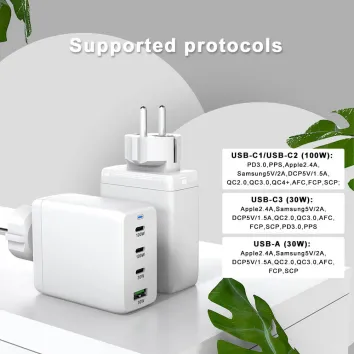November/December Travel Guide - Travel Chargers
Overview of charger specifications and voltages in various countries
When traveling abroad, since each country has different voltage and plug specifications, it is very important to choose the right travel charger. Common voltages and socket types around the world are as follows:

· United States, Canada, Mexico: 110-120V, plug types A and B
· Most of Europe (such as France, Germany, Spain, etc.): 220-240V, plug types C and F
· United Kingdom, Ireland, Malta, etc.: 230V, plug type G
· Australia, New Zealand: 230V, plug type I
· China, Japan: China is 220V, plug types A and I, Japan is 100V, plug types A and B
· Hong Kong: 220V, plug type G
· South Korea: 220V, plug types C and F
· Singapore, Malaysia, India, etc.: 220-240V, plug type G
>> Charger specifications for more countries
Travel charger
For users who often travel abroad, a charger that can adapt to different voltages and plugs can greatly improve the convenience and safety of charging. According to the commonly used digital products for travel, there are generally: mobile phones, watches, headphones, cameras, tablets, power banks, small drones, etc. Then 45W, 65W, 100W and 120W chargers are our mainstream choices.

Read More
1. Suitable for charging small devices such as mobile phones, tablets, headphones, etc., if it is a short-term and lightweight traveler or does not carry a laptop computer, it is fully satisfied.
2. Single and dual ports (USB/Type C), small size and easy to carry, suitable for short trips.

Read More
1. Suitable for people who work on the road or need to use multiple devices, can charge mobile phones, tablets, and small laptops (such as MacBook Air).
2. 2-4 ports (USB + Type C), the power is enough to provide sufficient power for most devices used in travel, and the GaN charger is small in size.

Read More
1. Business travelers, heavy digital device users, most digital products can be charged.
2. 3-5 ports (USB + Type C), fast charging protocol (QC 3.0/PD 3.0) can provide high-speed charging for large devices and reduce charging time.
120W charger: charging devices that pursue charging speed and high power requirements. But when traveling, a 100w charger is generally sufficient.
Recommendations on travel chargers
Number of chargers: If you are traveling alone or on a business trip, it is best to bring 2 chargers to avoid one of them getting damaged or lost. (2 people bring 3-4)
Choose a multi-port charger: A multi-port charger can support multiple devices charging at the same time, which can avoid the problem of insufficient plugs. Multi-port chargers are very convenient in places with limited sockets such as Europe and Southeast Asia.
Compatible voltage range: Most modern chargers support a wide voltage input of 100-240V, which is suitable for the voltage range of most countries in the world. However, in places with large voltage differences (such as 100-120V in Japan and the United States vs. 220-240V in Europe), it is necessary to ensure that the charger meets the local voltage standard to improve safety. >> Click here for details
2. 3-5 ports (USB + Type C), fast charging protocol (QC 3.0/PD 3.0) can provide high-speed charging for large devices and reduce charging time.
120W charger: charging devices that pursue charging speed and high power requirements. But when traveling, a 100w charger is generally sufficient.
Recommendations on travel chargers
Number of chargers: If you are traveling alone or on a business trip, it is best to bring 2 chargers to avoid one of them getting damaged or lost. (2 people bring 3-4)
Choose a multi-port charger: A multi-port charger can support multiple devices charging at the same time, which can avoid the problem of insufficient plugs. Multi-port chargers are very convenient in places with limited sockets such as Europe and Southeast Asia.
Compatible voltage range: Most modern chargers support a wide voltage input of 100-240V, which is suitable for the voltage range of most countries in the world. However, in places with large voltage differences (such as 100-120V in Japan and the United States vs. 220-240V in Europe), it is necessary to ensure that the charger meets the local voltage standard to improve safety. >> Click here for details
Fast charging support: Using a charger that supports fast charging protocols (such as USB PD or QC) can shorten charging time, especially for mobile phones, tablets and other devices that need to replenish power quickly.
Plug converter/conversion socket: When traveling in countries where plug types are not uniform, the conversion plug must be identified to see if it has safety certification such as CE/UKCA. It must be used correctly and in accordance with safety regulations to avoid causing current overload, short circuit and burning of equipment.
Plug converter/conversion socket: When traveling in countries where plug types are not uniform, the conversion plug must be identified to see if it has safety certification such as CE/UKCA. It must be used correctly and in accordance with safety regulations to avoid causing current overload, short circuit and burning of equipment.